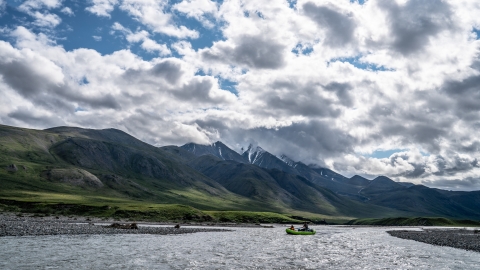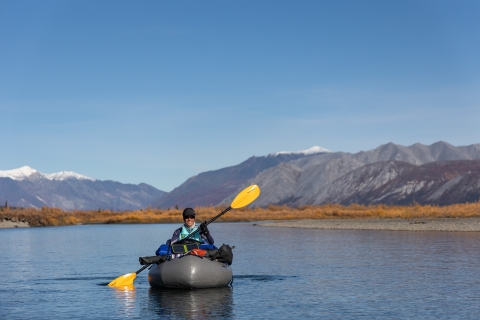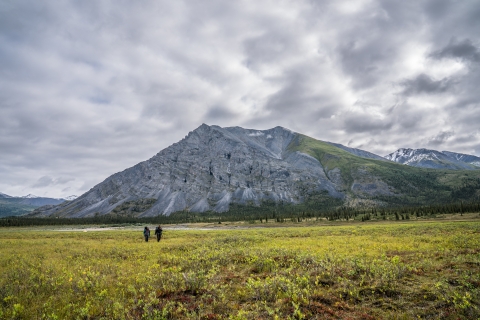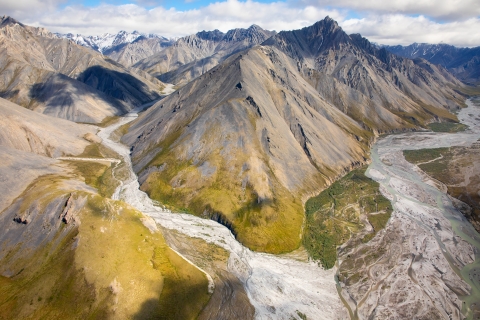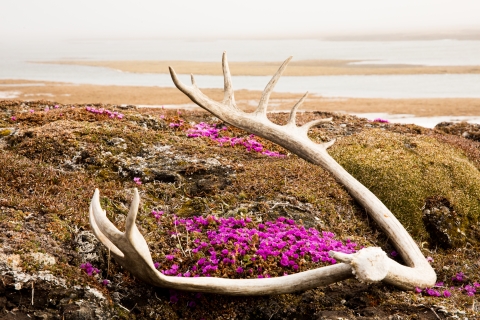December 9, 2024: The Bureau of Land Management issued the Record of Decision for the Coastal Plain Oil and Gas Leasing Program Supplemental Environmental Impact Statement and announced the lease sale: Congressionally mandated lease sale announced for Alaska’s Coastal Plain | Bureau of Land Management
Visit Us
National wildlife refuges offer us all a chance to unplug from the stresses of daily life and reconnect with our natural surroundings.
The Arctic National Wildlife Refuge, in the far northeast corner of Alaska, is a place of austere beauty driven by forces of nature. These lands, and the plants and animals that live here, evolved knowing only the light step of occasional nomadic hunters. Today, refuge lands continue to support a subsistence way of life for local residents. Visitors from around the world travel to the refuge for recreation and research. Most visitors plan a stay of 6 to 10 days while they camp, hike, float rivers, hunt, or fish.
Prepare to visit a truly wild place
All refuge lands are open to the public, and there are no visitor fees or specific entry points. Visitors plan and arrange their own transportation, trip locations, and itineraries; careful preparation, and self-reliance are a must. There are no roads, established trails, or facilities of any type within the refuge's 19 million acres. Most bring their own food and gear, and access the refuge by air taxi, flying in from nearby communities. First-time visitors may wish to participate in a guided trip. Even experienced visitors may wish to use the support of commercial recreational services (see Tours for information about authorized recreational guides, hunting guides, and air taxi operators). Although there is no cell phone coverage, satellite phones do work in many areas. Explore the Activities section and see Rules and Policies for additional helpful trip planning information.
Visit us in person at the Arctic Interagency Visitor Center
The nearest road to Arctic Refuge is the Dalton Highway, which runs north-south to the west of Arctic Refuge's boundary. Along this remote highway is the small community of Coldfoot, which is home to the Arctic Interagency Visitor Center, the only visitor center representing the Arctic National Wildlife Refuge. This visitor center has staff who offer trip planning assistance and orientations to the backcountry, and the center itself boasts award-winning exhibits. Please visit Arctic Interagency Visitor Center for more information.
Activities
Many more people visit these lands than in the past. This vast and remote landscape is a place of great power, but it is easy to scar and slow to heal. As a visitor, your experiences will be intertwined with the wildlife and habitats the refuge is meant to preserve, and your practices will influence the future well-being of this place.
We all share responsibility to preserve this wild place—the responsibility to have a limited impact on the land and to protect the intricate web of life it supports—so that those in the future may be rewarded and inspired in their turn. Thank you for your efforts to limit your impacts when on Arctic Refuge. We hope your visit is an experience to remember! Explore the following activities for more information. If you prefer to be guided, see Tours.
Trails
Arctic Refuge has no designated trails. Visitors have the freedom to respond to the landscape as it unfolds before them. Explore our activities section for tips on hiking and camping in the refuge, including leave no trace principles to minimize your impact on the fragile arctic environmetn.
Related Documents
Interactive map of Arctic Refuge.
Easements and private land
There are two areas of public easements across private lands within the refuge: along the north coast near Barter Island, and near Elusive Lake in the western portion of the refuge. These two maps show lands managed by the refuge in green and depicts public rights-of-way [called ANCSA 17(b) Public Easements] across private lands in orange:
Easements near Barter Island
Easements near Elusive Lake
Entry onto private lands is only allowed with prior approval from landowners. It is the visitor’s responsibility to learn about land status and to get prior approval before entering non-refuge lands. Private lands probably will not be marked with signs. Explore the interactive map to identify if your trip plans take you near private land, and either choose to avoid or seek permission from the landowners prior to travel.
Rules and Policies
All Arctic Refuge lands are open to the public at all times, and there are no visitor fees charged anywhere on the refuge. Hunting, fishing, and firearms are allowed following state regulations.
Safety and self-reliance
Ensure that you have the skills necessary for a successful visit. Know your expertise and limitations in remote, backcountry travel and survival.
Careful preparation and self-reliance are necessary for a successful visit to the refuge. Leave your itinerary with family or friends and put a safety plan in place before you visit.
Leave no trace
Large groups may leave especially noticeable and lasting impacts on fragile Arctic landscapes. Refuge employees and research project leaders limit their groups to the fewest necessary participants. Commercial guides are required to limit their group size. We encourage private users to do the same.
The recommended maximum group size is 7 people for land travel and 10 people for water travel.
The use of domestic sheep, goats, and camelids (i.e., llamas and alpacas) on Arctic National Wildlife Refuge lands is prohibited, due to concerns about disease transmission to Dall sheep and other wildlife.
Help us reduce the harmful introduction of invasive species invasive species
An invasive species is any plant or animal that has spread or been introduced into a new area where they are, or could, cause harm to the environment, economy, or human, animal, or plant health. Their unwelcome presence can destroy ecosystems and cost millions of dollars.
Learn more about invasive species ! Before entering the refuge, make sure clothing, equipment, vehicles and aircraft are clean by removing all dirt, mud and debris. Watch out for “hitchhikers”—those seeds that stick to your socks, clothing or domestic animals’ fur. Visitors who bring animals to the refuge should choose bedding and feed materials that will not introduce new plants by accident.
Leave natural objects and private property undisturbed. It is illegal to remove specimens from National Wildlife Refuges without a pre-arranged collection permit. Leave noticeable objects for others to enjoy.
Drone Users
The use of unmanned aircraft systems (UAS/drones) on Arctic Refuge is prohibited unless authorized in advance through a special use permit or letter of authorization.
Locations



















The Arctic National Wildlife Range reaches across more than 19 million acres (the size of South Carolina) in the northeast corner of Alaska. A truly wild landscape, the refuge contains no public facilities, but does contain three Wild and Scenic rivers and the largest designated Wilderness (about eight million acres) in the National Wildlife Refuge System.
The majestic Brooks Range, with peaks and glaciers to 9,000 feet, dominates the refuge. These rugged mountains extend east to west in a band 75 miles wide, rising abruptly from a flat, tundra-covered plain. This treeless expanse is cut by numerous braided rivers and streams. South of the continental divide, rivers wind serpentine courses through broad, spruce-covered valleys dotted with lakes and sloughs.
The refuge includes an array of landscapes and wildlife habitats: from the boreal forest of the Porcupine River uplands, to the foothills and slopes of the Brooks Range, to the arctic tundra of the coastal plain, to the lagoons and barrier islands of the Beaufort Sea coast.
The ground lies permanently frozen below much of the refuge. This impenetrable "permafrost" layer causes many areas to remain wet during the summer. Plants grow rapidly with 24-hour daylight, but the growing season is short. These factors make the refuge a fragile area easily impacted by human activities. In this most northern of refuges, plant communities take a long time to recover from disturbances.
Although the Dalton Highway passes close to one small section of Arctic Refuge, most visitors arrive by air. Kaktovik, Deadhorse, Arctic Village and Fort Yukon are the communities located nearest to Arctic Refuge. These remote communities receive regularly scheduled air service from Fairbanks. From there, you may charter authorized commercial air operators to fly into and out of the Refuge based on trip arrangements made with the air operators. There are no constructed landing strips or facilities within the Refuge.



















Arctic National Wildlife Refuge main offices are located in Fairbanks, Alaska.
Phone Number: 800-362-4546 or 907-456-0250




